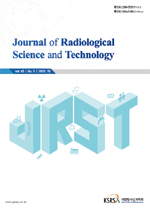소아 X선 촬영조건 변화에 따른 소아 및 촬영보조자 선량
Doses of Pediatric and X-ray Examination Assistants according to Changes in Pediatric X-ray Exposure Conditions
- 대한방사선과학회(구 대한방사선기술학회)
- 방사선기술과학
- 제46권 제5호
-
2023.10409 - 415 (7 pages)
-
DOI : 10.17946/JRST.2023.46.5.409
- 17

Although pediatric X-ray examinations are continuously increasing, there are not many studies on the radiation exposure to children and X-ray examination assistants according to X-ray Exposure conditions. Accordingly, we measured the radiation exposure dose of pediatric and X-ray examination assistants according to the standard guidelines and clinical average X-ray Exposure conditions when X-ray examination 10-year-old children. The effective dose and organ dose to pediatric were measured using an Dose area production meter and Monte Carlo-based PCXMC program, and the exposure dose of X-ray examination assistants was measured using an ion-chamber. When performing abdominal supine AP projec-tion, the effective dose to children was up to 2.38 times higher under clinical average X-ray Exposure conditions than the standard guidelines. In addition, during abdominal supine AP projection, the radiation exposure dose to the X-ray exami-nation assistants was highest on the hands at 0.0148 ∼ 0.0709 mSv, and exposure dose could be reduced by up to 35% when wearing protective gloves. In conclusion, because the X-ray Exposure conditions used in clinical are unnecessarily high, unnecessary medical radiation exposure could be reduced if appropriate X-ray Exposure conditions and the radiation field area were minimized and the assistant wore shielding gloves.
Ⅰ. 서 론
Ⅱ. 실험 재료 및 방법
Ⅲ. 결 과
Ⅳ. 고 찰
Ⅴ. 결 론
REFERENCES
(0)
(0)